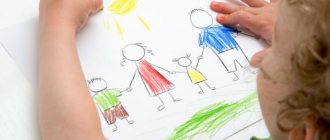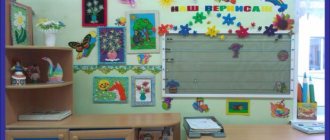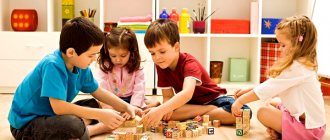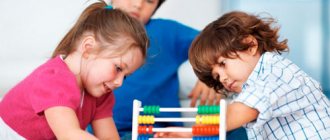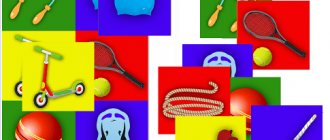Corner of psychological relief “Fairy Room”.
Goal: maintaining the psychological health of children in a preschool institution.
We live in an era of crises and social change. Today's preschoolers are affected by the economic and value instability of society. A multi-generational family is giving way to a one-child family; accordingly, the process of socialization occurs with a lack of communication. What makes childhood different is the widespread introduction of early education, which leads to a redistribution of the pace of development of cognitive processes. And as a result, more and more often we see children with external signs of adulthood (intellectualism, excessive rationalism) with internal social immaturity and infantilism. The child is forced to grow up earlier, but at the same time remains helpless when faced with difficult life situations. The adults around the child are able to create conditions for his full development.
The basis of such development is psychological health. The term “psychological health” was introduced by I.V. Dubrovina. What is meant by a psychologically healthy person? A person is spontaneous and creative, open, cognizing himself and the world around him not only with his mind, but also with his feelings. He fully accepts himself and at the same time recognizes the uniqueness of the people around him. Such a person takes responsibility primarily on himself and learns from unfavorable situations. One could say that the key words to describe mental health are “balance, harmony.” And the central characteristic of a psychologically healthy person can be called “self-regulation.”
The very use of the term “mental health” emphasizes the inseparability of the physical and mental in a person. The problem of the relationship between the psyche and the body has been well studied by psychosomatic medicine, which, as an illustration, cites the results of a study of the psychological characteristics of people who have successfully lived to 80-90 years of age. All of them had optimism, emotional calm, the ability to rejoice, self-sufficiency and the ability to adapt to difficult life situations. Children who attend preschool institutions today lack these qualities. A large percentage of kindergarten students are children who express emotions of anger with aggression, who do not know how to negotiate, who have difficulty adapting to life in a group of children and who do not respect the other person, his feelings, mood and emotions.
Accepting yourself for who you really are is a sign of mental health and an indicator of personal growth. Self-acceptance largely determines the nature of interaction with other people. Therefore, the development of this feeling must be given serious attention and developed in children.
The relevance of the problem of preserving and strengthening the psychological health of preschool children is obvious. To solve it, it is necessary to create appropriate conditions and organize the subject environment. Unfortunately, the realities of today are such that not every preschool institution can boast of having a psychological service on staff. The task of preserving the psychological health of children falls on the shoulders of the educator.
For this purpose, a subject-developmental environment was created in the kindergarten “PSYCHOLOGICAL UNLOADING CORNER “Fairy Room”. To create it, the main directions for transforming the educational environment were identified.
The development was based on the following principles:
— flexibility and controllability of the environment. Taking into account the limited space of the group room, all materials are distributed depending on the ease of use in the group room or bedroom. - activity, independence. The opportunity is provided for free access to materials, initiation and encouragement of the need of preschoolers to independently find solutions to non-standard problems and problematic situations; — individual approach to each child. Taking into account personality characteristics (temperament, mood, intellectual capabilities) in the formation of positive ideas about oneself.
The material for the corner was selected taking into account its main purpose, namely:
*for psychological relief of pupils; *learning ways to express anger in an acceptable form; * teaching preschoolers the ability to control themselves in various situations, self-regulation techniques; *teaching children conflict-free communication; *increasing the self-esteem of anxious, insecure children; *teaching preschoolers cooperation skills and coordinated team actions.
For example, the presence of upholstered furniture in the corner makes it possible to relax and helps relieve tension and lift your spirits.
“Pillow with stubborn people” solves the same problems.
The “Anger Rug” is designed to relieve emotional stress and express such negative emotions as anger in a form acceptable to others. For the same purpose, there is a scream bag in the corner.
The “Magic Oak” is located in the corner.
Its goal: to raise the child’s self-esteem and build confidence. To do this, the child is asked to sit down near an oak tree, which symbolizes leadership and protection. And the rest of the children are given the task of coming up with as many kind and gentle words and compliments addressed to their friend as possible. After this, the children approach the magic oak tree, and, stroking the child sitting on it, say kind words to him. This is how children learn positive self-acceptance and create their own positive “I-image.”
To relieve tension and stabilize the emotional state of young children at the adaptation stage, games are used aimed at developing fine motor skills of the hands, nursery rhymes, when pronounced, children can touch and stroke one or another forest dweller in the “Good Affectionate Friends” zone, accompanied by a nursery rhyme :
A small bunny is jumping around the rubble. The bunny jumps quickly, you catch him.
You can calm down naughty children and teach them one of the techniques of self-regulation in the “Zone of Calm Games and Secrets”, here they use games for physical contact and relaxation exercises.
An important attribute of the psychological corner, the purpose of which is to introduce children to various emotional states, as well as teach preschoolers to convey these emotional states using various means of expression - “Mirror Lake”. It has the shape of a lake on the wall, next to which there is grass, pebbles, frogs, and turtles. For example, to activate a positive emotion to eliminate or reduce the intensity of experienced sadness, you can tell a story.
The “psychological relief corner” also contains materials that the teacher uses in his work. This is a selection of psycho-gymnastic games aimed at developing positive self-acceptance and tolerance.
Thus, it is recommended that in each group of a preschool institution create conditions for the psychological health of preschoolers as an important component in the formation of an open, creative personality.
Games used in the psychological relief corner “Fairy Room”...
Author: Sayfutdinova Tatyana Aleksandrovna, teacher-psychologist, MBDOU d/s "Solnyshko" of a general developmental type with a priority direction of artistic and aesthetic development, Yamal-Nenets Autonomous Okrug, Tyumen region, Gubkinsky, Russia
The article is published in the author's edition
Corner of relaxation and psychological relief.
Tatyana Pivovarova Corner of relaxation and psychological relief
Children are not always comfortable being in a large group; sometimes they want to be alone and relax. For this purpose, in our 2nd junior group “Gnomes” a corner of relaxation and psychological relief has been created.
There are 2 cats on the wall - “mood indicators”. A child can come up and “treat a fish” to a sad or happy cat, depending on his mood. Fish with attached flat magnets are attached to magnetic “bowls”
A “house”-tent is placed in this corner, where children play one or two at a time.
On the shelves are toys specially selected for rest and relaxation:
1. Water clock. Children watch colored drops slowly falling.
2. “Dry pools” with acorns, colored buttons, beads from Christmas garlands, a container with beads that can be strung on a string.
3. Homemade relaxation toys:
- from a plastic bottle, food coloring with water and “Sea” sunflower oil
- from plastic bottles and shower gel (of course, the bottles are tightly sealed, beads are added to one. Children love to watch how, when turning over the gel, an air bubble slowly runs up, and beads slowly and slowly fall down.
Second bottle (green)
in the image below.
5. Organ organ (monotonous calm music promotes relaxation and psychological relief)
6. Hourglass (issued for a short time and strictly under supervision)
7. Massage balls
8. Figure toys that fold when pressed
9. Logical toy “Snake”
10. Calendars with an iridescent image of a “Horse”. Stereo pictures are good for the eyes: focusing your gaze on a specific object strains and then relaxes the eye muscle. This has a positive effect on visual acuity: the percentage of vision increases, it becomes clearer.
11. Homemade tabletop sandbox “Masha and the Bear”
12. Sensory toy like a tabletop sandbox “Sea in a box”
13. “Mood glass” - when you are angry, you can say angry words into it and close the lid so that they don’t fly away. :)
I will be glad if it is useful to someone!
Mood Corner To create an emotionally comfortable environment in the group, a “Mood Corner” was created. I offer my corner of mood, decorated in.
Decorating a nursery group A kindergarten is a second home for the teacher, and of course for the children. In the early age group, I decided to decorate the corner according to the seasons.
A corner of solitude in a kindergarten.
An effective form of work is to create a “Privacy Corner” in each kindergarten group.
Sometimes in the literature you can find the name “Mood Corner”, which is also correct, as it reflects the essence of the purpose.
This form of work allows you to solve problems such as:
- organize work to normalize and develop the emotional sphere of children;
- create a positive emotional microclimate in the group.
And for early age groups, this is another wonderful opportunity to facilitate adaptation.
A “corner of solitude” is a place where a child in kindergarten can feel completely safe, can calm down, relax, play with his favorite toy, look at photographs, books, “call” his mother, or just dream.
Such a “children's place” helps prevent excessive excitement of the child, leading to fatigue of his nervous system.
You don’t need a lot of space to organize a corner of privacy. It should not be bulky in size, but can resemble a small cozy house, marquee, tent. The main thing is that the child feels protected in it. This place should be attractive to the child, but at the same time it is not recommended to use too bright colors in the design. It is possible to place landscape paintings, relaxation lamps, and sound waterfalls. A soft rug and colorful pillows, or a cozy child's chair or modules are required on the floor.
The equipment of such a corner is of great importance. There may be photo albums with group and family photos, a “phone”.
A special niche is occupied by toys for relieving mental stress. It can be:
— cups for screaming, pillows for beating;
- a box for bad feelings (the child expresses all his grievances in the box, can draw his anger or resentment and also put it there, they take the box with them outside and “throw away” all its contents there);
- anger rug (a rug with a rough surface, the child takes off his shoes and wipes them on his feet until his mood improves);
- mood mirror (a mirror to which is attached an album with schematic images of faces expressing different moods; a child, looking in the mirror, tries to display this or that emotion on his face);
— a set for drawing, modeling (sheets of paper, pencils, felt-tip pens, plasticine);
- a reconciliation box (a box with holes on both sides, children insert their hands and shake them with each other);
- a mood cube (various emotions are drawn on the sides of the cube; the child, looking at it, selects the side that shows what he feels, and then chooses the one he would like to feel). The manual “Flower of Emotions” works on the same principle;
— “The Book of Kindness” is an album with only kind fairy-tale and cartoon characters posted, plot pictures depicting scenes of good deeds.
What is a sensory room for?
Indications for exercises in the sensory room may include:
- neurosis-like conditions,
- adaptation disorders,
- disturbances in the emotional sphere (fears, isolation),
- psychosomatic diseases,
- stress, depression, psycho-emotional tension,
- muscle tension,
- behavioral disorders (aggressive behavior),
- attention deficit hyperactivity syndrome,
- weakening of sensory functions (vision, hearing, touch),
- delayed speech and psychomotor development,
- residual organic lesions of the central nervous system,
- motor dysfunctions,
- mild forms of autism,
- enuresis and encopresis,
- nervous tic,
- stuttering.
Also in the corner of solitude there can be various educational games and toys:
— theater screen with a set of toys for theatrical activities (Bi-ba-bo, finger toys);
— tactile, sensory mats;
— games for the development of fine motor skills (stringing, sorting by shape, by color);
- balls of multi-colored threads (for unwinding and rewinding);
— didactic games for studying emotional states: “Feelings and emotions”, “What friends act”, “Guess the emotion”, “Find friends”, “Events and emotions”, “My feelings”, “Emotions in fairy tales”.
It is important to remember that all these games and toys should not be stored in a corner permanently. All paraphernalia changes periodically, is updated and replenished as necessary.
The effectiveness of the work depends on how aware the children are of the purpose of the corner, its equipment and the ability to use the attributes. Therefore, children are introduced to the corner immediately after its organization, invited to look around and try out the toys. As a new attribute is introduced, children are shown different ways to manipulate it.
It is also useful to teach children breathing exercises, which calm the nervous system and balance their emotional state. These include:
"Walking Around the Room"
Walking around the room for 1-2 minutes. Breathe deeply, inhale for 2 steps, exhale for three steps. Breathing through the nose.
"We reached out"
IP: standing, legs together. Slowly raise your arms up and connect them above your head. Lock your fingers and turn your palms up. Rise on your toes, stretch up – inhale, return to the I.p. – exhale. Monitor the completeness of your inhalation. Repeat 3-4 times.
In the corner there may be schematic cards that will remind the child about breathing exercises and the technique of performing them.
In the kindergarten “Privacy Corner” in the group.
According to the existing requirements for the organization of a developmental environment in educational institutions, it is necessary to create comfortable conditions in preschool educational institutions not only for active activities of pupils, joint games, classes under the guidance of a teacher, but also for psychological relief and recreation for children. When spending the whole day in a noisy group, a child may need personal space. For this purpose, a “Privacy Corner” is placed in the kindergarten. What such a zone is, how to make it with your own hands and what items to fill it with, we will tell you in this article.
Sensory room - what is it?
A sensory room can be defined as a specially organized environment filled with various kinds of stimulants, the purpose of which is to influence the human senses. A sensory room is popularly called a “relaxation room,” but in essence, a sensory room can be used not only to provide a calming and relaxing effect, but also to achieve a tonic and stimulating effect. The secret lies in the combination of different stimuli. These include: light and color, sounds (music), smells, and tactile sensations. Sets of stimuli can be grouped depending on the receptor they act on.
The purpose of the “Privacy Corner” in kindergarten
Preschool children often change their mood due to insufficient development of the emotional-volitional sphere. Children do not yet know how to control the manifestations of their feelings. Therefore, there is often a demonstration of such emotional manifestations as anger, rage, and sadness. For a child, changing the environment, staying all day in a noisy circle of people in the absence of his mother, as well as fulfilling the requirements of teachers and accepting a large amount of new information is serious stress. Therefore, to maintain the psychological comfort of a preschooler, special areas are created in groups where the child can be alone. In such a corner, the baby can “hide” from others, express his accumulated negative emotions, distract himself from the hustle and bustle with the help of interesting, quiet games and simply relax in silence.
Thus, the “Privacy Corner” in kindergarten helps solve the following psychological and pedagogical problems:
- create conditions for the development of the emotional sphere of a preschooler;
- help children adapt to new conditions, peers, teachers;
- create a positive microclimate in the children's team;
- prevent nervous overstrain of pupils, reduce the likelihood of conflict situations.
Types of sensory rooms
Relaxation sensory room
Typically, this room has soft coverings, wall and floor mats. It contains ottomans and cushions, a rocking chair that follows the contours of the human body, and a dry pool with safe mirrors. It is equipped with lighting devices that create diffused light, have a fiber-optic effect (starry sky, starry rain), and suspended movable structures (mirror ball, dry rain). Such a room is complemented by an aromatherapy installation and a music system for playback.
The following set of stimuli is used here: soft floating light, soothing music or sounds of nature, a pleasant smell, a comfortable free posture combined with tactile sensations of weightlessness, softness and tenderness.
Activation sensory room
The room is covered with touch panels for hands and feet (special touch
foot paths, air bubble tubes that create vibration when touched). The room is equipped with lighting devices that have a light-optical effect and sound (interactive panels, spotlight systems). There is also a system for playing music or sound sets. Massage balls and other similar things may be present. To enhance the lighting effects, the room can have special mirrors that can visually change the area of the room to a larger extent.
The following set of stimuli is used here: bright light, creating an atmosphere of celebration, fun, tonic sounds, tactile effects (tingling) on skin receptors and muscle receptors, leading them to a state of excitement.
Recommendations for design
In a kindergarten, the “Privacy Corner” should be a closed, comfortable space. The child needs to feel safe and confident that no one will disturb him in this area. Therefore, most often such a corner is designed in the form of a hut, tent, house.
It is important to create an atmosphere of home comfort and tranquility. Therefore, it is recommended that the interior of the space should have dim lighting, a lot of pillows, a soft comfortable sofa, paintings and other little things that will help realize the idea.
Of course, it is necessary to take care of the safety of children. So, under no circumstances should small, sharp or breakable objects, paints or other chemicals be placed in the corner. A “window” should be provided in advance so that in some cases the teacher, without disturbing the child or violating his personal space, can make sure of his safety and well-being.
How to make a “Privacy Corner” in kindergarten? The design depends on the interior of the group, as well as the preferences of the children themselves. Pupils can take a direct part in the production and decoration of such an area.
Contraindications and restrictions for using the sensory room
Contraindications are severe mental retardation, epilepsy, infectious diseases. The limitation is hyperactivity and various neuropsychiatric diseases, the treatment of which is carried out with the use of psychotropic drugs.
Conclusion
The study of sensory systems is actively developing. The effect of receptors on the brain occupies the minds of many scientists around the world. And although the research has not yet been completed, you and I already know that the sensory room is undoubtedly a unique “invention” and has a positive effect on the human body.
Author: Ekaterina Solovyova
Please note that the information presented on the site is for informational and educational purposes only and is not intended for self-diagnosis and self-medication. The selection and prescription of medications, treatment methods, as well as monitoring their use can only be carried out by the attending physician. Be sure to consult a specialist.
Design ideas
You can make a “solitude corner” in a kindergarten with your own hands, for example, in the form of a “fairytale tent”, “gnome’s house”, “magic cave”, “sunny room”.
We offer simple and affordable ways to make such a play area:
- Separate off one corner of the group room with a curtain attached to the cornice. If desired, you can decorate the fabric, for example, with stars, flowers, smiley faces.
- You can make a corner from a factory children's tent. An appropriate size mattress and plenty of decorative pillows should be placed on the floor.
- You can build a full structure. So, the frame is made of plastic pipes. Then it is covered with fabric and decorated with trim.
Depending on the preferences of the children in the group, you can create a comfortable themed “Privacy Corner” in the kindergarten. The photo below shows the personal space area in the form of a “princess tent”.
Classification of stimuli
Light therapy and color therapy affect vision. Soft light - peace. Bright light - excitement. In addition, light particles (photons) maintain the rhythm of daily fluctuations and improve the condition of the immune system. Color therapy is used, for example, red – stimulation, orange – restoration, yellow – toning, etc.
Sound therapy – affects hearing. It can be passive (a person listens to sounds or music) and active (a person creates sounds or music himself). Calm melodic music, sounds of nature - peace. Mechanical sounds, electronic music, pieces with different tonal strengths (works by Mozart), pieces of music with a fast tempo (waltzes) are exciting.
Aromatherapy – affects the sense of smell. Pleasant smells mean peace. Strong smells – excitement. In addition, essential oils have bactericidal, antiviral and anti-inflammatory properties.
Tactile sensations affect skin receptors. Feelings of softness, warmth, tenderness - peace. Tingling, pressure, vibration - excitement. Using massage devices relieves muscle tension and improves blood circulation.
The equipment that makes up the sensory room can be roughly classified into two types: relaxation and activation. The rooms themselves can be divided in the same way.
Games to improve your mood
“Having let off steam,” the baby needs to calm down and recharge with positive energy. Therefore, the central place in such an area is occupied by a comfortable sofa with pillows. Nearby you can place a small table for board games. In addition, in kindergarten, the “Privacy Corner” may contain the following items:
- sensory pads and other fine motor games (e.g. sorters, insert games, cereal boxes, kinetic sand, massage balls);
- photo albums;
- materials for development and creativity (pencils, markers, paper, books);
- “box of wishes” for children’s drawings;
- dolls with which the baby can share his “secrets”;
- toy phone for “calling mom.”
It is recommended that soothing music (sounds of nature) be played in such an area.
Literature
- WAVE. Teaching children diaphragmatic breathing: Methodological manual / Comp. Ledina V. Yu., Zubova N. A. - St. Petersburg, 2003.
- Rogov E.I. Emotions and will. - M.: VLADOS, 1999.
- Martynov S. M. The child’s health is in your hands. - M.: Education, 1991.
- Monina G. B., Rannala N. V. Training “Resources of stress resistance”. - St. Petersburg: Rech, 2009.
- Sensory room: Abstract and guidelines for use. - St. Petersburg: Alma, 2007.
- Dry pool. Methods of conducting games, activities and exercises: A manual for teachers, psychologists and parents / Ed. L. B. Baryaeva. - St. Petersburg, 2008.
The author of the article is S.A. Petrushin. Material provided by the magazine PRESCHOOL PEDAGOGY, issue of October 2012.

